“You wait for a gem in an endless sea of blah.” -Lawrence Grossman
On the one hand, we have General Relativity, our theory of space, time, and gravity.
It describes the Universe on both large and small scales perfectly, from the hot Big Bang to our cold accelerating expansion, from vast superclusters of galaxies down to the interiors of black holes.
But General Relativity doesn't tell us everything. It doesn't tell us, for example, about protons, neutrons or electrons. It doesn't tell us the properties or interactions of matter and energy in the Universe. It only tells you about gravitation: how spacetime affects the matter and energy in it and how the matter and energy respond, gravitationally, to the spacetime they exist in.
But that does include, when an excessive amount of mass/energy gets concentrated in one region of spacetime, black holes.
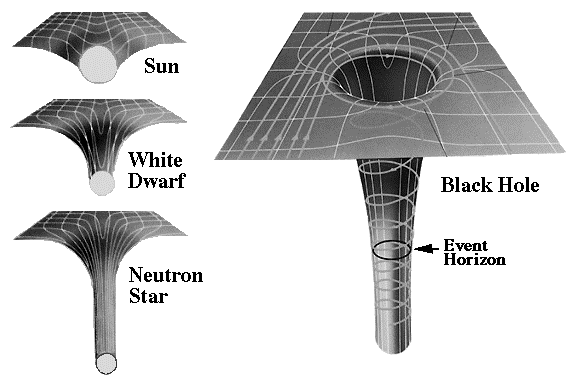 Image credit: anrophysics 2008-09, via Bangkok Patana School http://www.patana.ac.th/.
Image credit: anrophysics 2008-09, via Bangkok Patana School http://www.patana.ac.th/.
But if you want to properly describe the matter and radiation that lives in this spacetime, you need something else.
You need equations and laws that govern each individual quantum of energy and all of their interactions. You need the Standard Model of Elementary Particles, and all the laws that govern their interactions.
For that, you need quantum field theory. This is fully relativistic, and is the most complete way we have of describing the interactions of all matter, energy, and fields in the Universe.
It's incredibly complex, but it's calculable using a variety of techniques.
The problem -- and the source of many paradoxes -- is what happens when we try to put General Relativity and Quantum Field Theory together. Because we don't have a quantum theory of gravity, this typically means using General Relativity to figure out how the background spacetime is configured, and then using Quantum Field Theory in that curved spacetime to figure out the nuances of how that particle behaves.
I've done exactly one calculation of QFT in curved spacetime in my life (the one to derive Hawking radiation), and it was one of the most difficult calculations I've ever done.
Recently, another paradox has emerged that you might have heard of: that of Black Hole Firewalls.
If you fall in towards a black hole, you wouldn't notice anything special other than the gravitational redshifting of light and the increasing gravitational tidal forces as you fell in.
As you got close enough to the event horizon, you'd pass through ISCO, or the innermost stable circular orbit, interior to which there would be no matter or radiation. The black hole eventually swallows your field of vision, and into the event horizon you go.
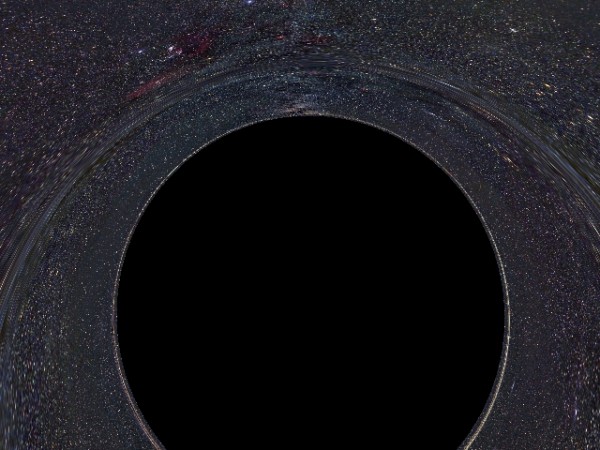 Image credit: Andrew Hamilton, who has some great visuals at http://jila.colorado.edu/.
Image credit: Andrew Hamilton, who has some great visuals at http://jila.colorado.edu/.
According to standard General Relativity, nothing funny or fancy should happen to you as you cross the event horizon, just the same small increases in tidal forces as you continue to approach the singularity.
But the "Firewall paradox," discovered last year, appeared to show that an intense firewall of radiation existed everywhere at once along the event horizon in a large black hole, and would incinerate anything or anyone that attempted to cross in horrific fashion.
Here's the thing: when two quantum systems are entangled, you can know the properties of one particle by measuring the properties of the other. For example, I can entangle two photons so that one has spin +1, and the other has spin -1. If I measure the spin of one, I immediately know the spin of the other. But if I don't measure the spin of either, they both remain undetermined.
The paradox comes about when you have two entangled particles, and one -- but not the other -- falls into the black hole.
 Image credit: Oracle Thinkquest, via http://library.thinkquest.org/.
Image credit: Oracle Thinkquest, via http://library.thinkquest.org/.
If you break the entanglement, by say, measuring the properties of the one that didn't fall in, a barrier of energetic particles would descend around the event horizon of the black hole; that's where the alleged firewall comes from.
At least, that was the paradox, as it was stated last year. But three physicists that you've probably never heard of -- Samuel L. Braunstein, Stefano Pirandola, and Karol Życzkowski -- have come up with the resolution here!
The fun thing that they found, here, is that the greater the entanglement across the event horizon of the black hole, the later the firewall curtain falls. More entanglement = more time.
So you'd think that this would be good for large black holes and bad for small black holes, naïvely, and this could have been the case. But in our Universe -- as this paper shows -- entanglement across all black hole event horizons is maximized, which means that the time it takes the firewall curtain-to-fall is... infinite.
In other words, entanglement is maximized and the black hole firewall never forms.
So you won't get fried as you fall into a black hole, even if you wait an arbitrarily long time. You can wait and wait and wait all you want, but infinity never comes.
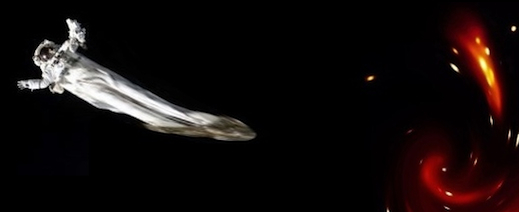 Image credit: Ashley Corbion of http://atramateria.com/.
Image credit: Ashley Corbion of http://atramateria.com/.
So when you fall into a black hole, it's death by spaghettification, not by incineration! And that's the end of the Black Hole Firewall Paradox!
- Log in to post comments

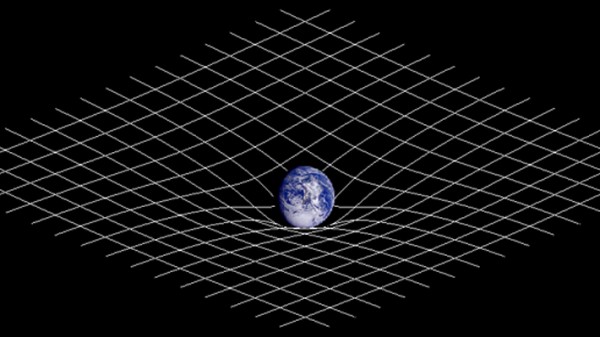
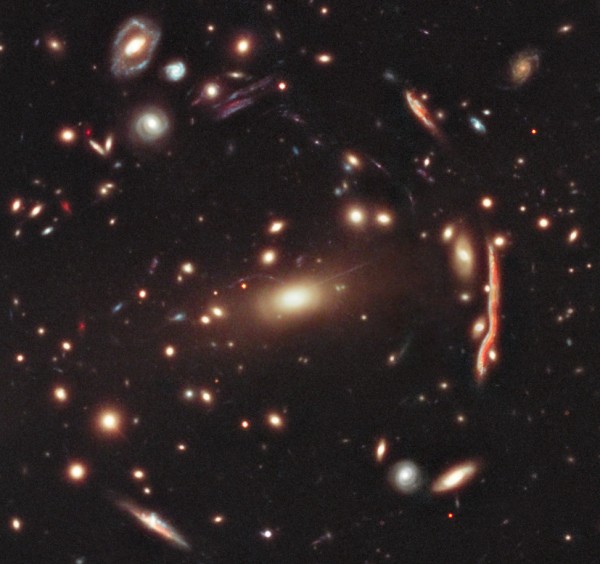
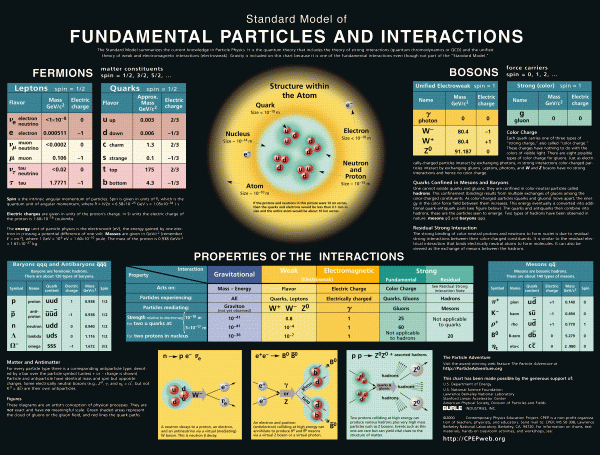
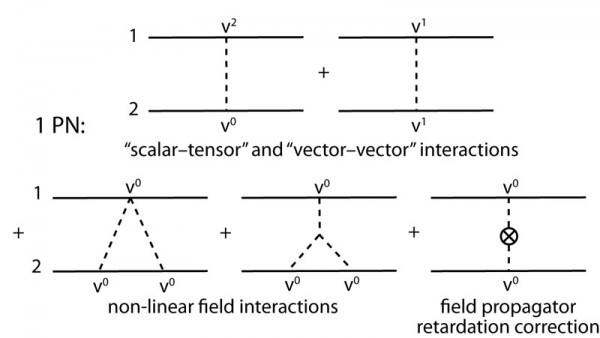

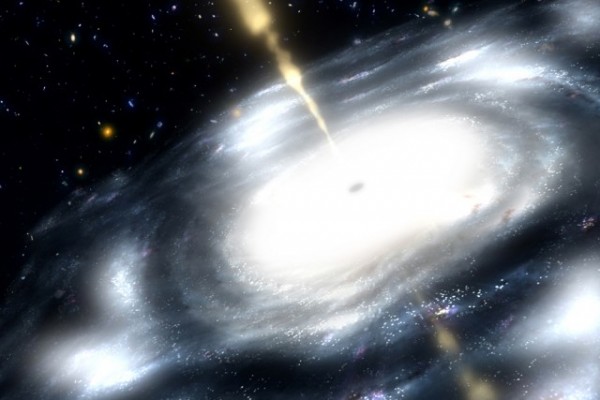
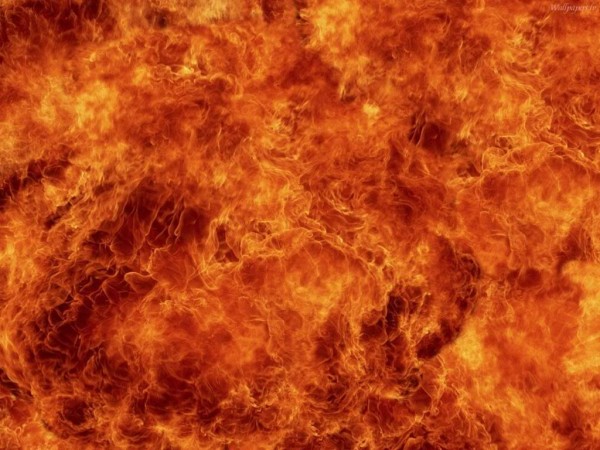
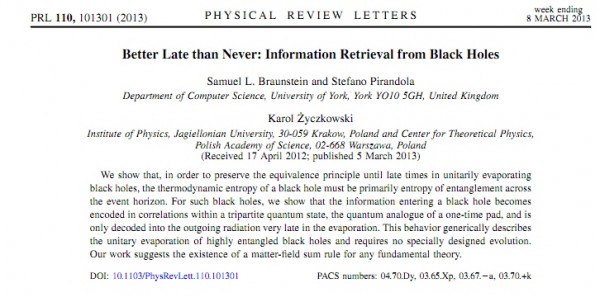
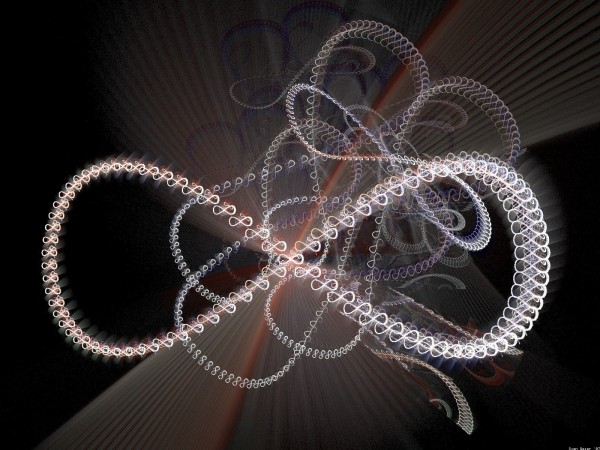
And for a large black hole, death by boredom.
You'd be thinking "Where are all the special effects?". Art. Sexing up the ordinary for over 300 years.... :-)
Even without a firewall, I'd expect death by x-rays long before spaghettification.
"Black Holes Won’t Incinerate You, After All"
Perhaps, but I cannot imagine that it is a healthy environment.
Therefore, Hawking still loses his bet and Total Baseball, The Ultimate Baseball Encyclopedia still goes to John Preskill and information can still be stored and not lost in the black hole by becoming part of the event horizon, as a hologram. I wonder whether Susskind was getting worried for the moment. The firewalls and the incineration put the Holographic Principal on shaky terms.
This paper is completely wrong! The authors don't understand QM.As I pointed out in 1991 (Proc of the Santa Fe conf on Found QM) QM acts as a singular perturbation on GR and there is no event horizon.
Yeah, george.
That's entirely how a scientist counters a paper. Just claims "This paper is completely wrong! They don't understand it at all!!!".
Yeah, right.
Problem is, you're not that George at all, are you.
Actually this paper almost literally satisfies Pauli's famous dictum of being "not even wrong." There are no results. Nothing is calculated at all and the authors simply talk and wave their hands. It's embarassing for Physical Review Letters. Actually that's also true in the 'firewall' papers.
What actually happens at the edge of a 'black hole' will be determined in the next 5-10 years by astrophysical observations. But George is right. There are good reasons to think there is a real surface there. See arXiv:gr-qc/0109035.
Is the human mind information? Is the Goldberg Variations information? Is 'General Relativity' information? If so, then what happens when our physical selves die? Does Plato's Ideals, Fermats Last Theorem, Archimedes Screw disappear?
No. No, No. The same thing as happens to the movement of an object that comes to rest: it stops. No.
@ William McDill
When talking about information in Physics, it's not talking about what you or I or anyone else knows. It's not about that.
A single piece of information or "bit" or "qbit".. depending on system, is a basic value of information about a system. i.e. if electron has spin up or down. You could say "0" for up, and "1" for down... or "A" and "B"... matters not. Very similar to computers. i.e.
Let's say I take your name "William" and I say it has 7 letters. Or I could say that it has 7bits. Of course this isn't really true.. your name doesn't have 7 bits in computer terms.. but as explanation you get the idea.
The thing is.. the Law says you can never ever destroy that info. It might get ripped apart, mixed with something else, one bit might be here, the other in a different galaxy or in Black Hole. But they still exist! In principal... if you knew everything that happened to every single of those bits, you could always reconstruct that package "William" from original bits that constitute it.
That's what meant by information.
Thank you! I appreciate being told that this paper made it through peer review and that some in the physics community accept it.
Even though the write up and the characterization of the authors (all 3 physicists, or 1 as coauthor?) seems a bit simplified to me. I thought the moral was that there is some as of yet unknown sort of quantum "code" protection of the entangled information, until the black hole evaporates and regurgitate it as nicely as it once ate it.
@george chapline:
They are working against the accepted theory, which has an event horizon, you can't fault them for that (and in fact you would have to fault them else).
If you do, you are "completely wrong!"
@Blackmage:
They do present a lot of (they claim new) results. Why don't you go have a read before commenting? That is, and excuses for using the same characterization as for george but it suits sooo well, “not even wrong.”
@Ian Liberman
But the paper has the information encoded all over: "The simultaneous encoding of information externally (in the combined radiation and external neighborhood) and
‘‘internally’’ (if one slightly stretches the horizon to envelop the bulk of the external neighborhood entanglement in addition to the black hole interior)".
They also refrain from specifying the new proposed physics outside of its entanglement effects. How should we test that it is holography?
[Which, as I understand it is not about where information lives but a correspondence between 4D physics that approximates ours and a 3D conformal physics. The entire 3D embodiment is analogous to a hologram, there is no actual subset becoming a hologram projection.]
And it would be "principle", wouldn't it? A principal is "highest in rank".
But... Aren't you only relatively spaghetti-like?
And, how can black holes actually be a singularity if they didn't start with an infinite amount of mass? I mean, I'm sure they're a hell of a lot closer to infinitely dense than regular matter, very closely approaching it even, but wouldn't you ultimately get compressed with an (almost) infinitely dense ball of matter? Seems to me like it'd be death by squishing.
"...you’d pass through ISCO ... The black hole eventually swallows your field of vision ..." Yes, but you could still "see" out wouldn't you, at least directly "up", wouldn't you see an intensely blue-shifted point of light of the external universe?
Does this mean The Flying Spaghetti Monster is located at the Event Horizon? Bring on the beers! Ramen.
That should have read... "The Flying Spaghetti Monster, in hiser infinite existence, lives at the Event Horizon"... :-)
Gabe, infinity isn't being reached, not in any finite time.
But the singularity is where it's so small, you can't tell the difference between zero size and the size it is.
Spagett!
While I think the picture of the object resting on a two dimensional plan and distorting it into the third dimension, I try to wrap my head around the fact that it isn't a two dimensional plane but three dimensional space. I somehow can't visualize this even though I can conceptualize this. Are there any pictures out there showing it visually?
It's not much of a shift than looking at a photo with perspective lines on it.
We're just built to see this 3D world with our 2D vision (beyond a few score meters, binocular vision adds nothing), so we're mostly fine with it, though our mind can be fooled, hence the optical illusions.
Your best bet is to think of it in three dimensions and thinking how it would look to something who can only see the planar surface.
"Black Holes Won’t Incinerate You, After All"
Really.
I'll read the firewall theory and the rebuttal and assume that they are correct.
OK. So we won't be incinerated that way.
But what about spinning black holes. Like spinning at near the speed of light. http://www.nasa.gov/vision/universe/starsgalaxies/spinning_blackhole.ht…
In my mind, galaxies are spinning and so the supermassive black holes at center of galaxies should be spinning. Specifically, I find it impossible to imagine a non-spinning black hole; just as I find it impossible to imagine a non spinning solar system or galaxy or even planet or moon.
But no one good measure the speed of the spin at the event horizon of a black hole until now. Well 84% of the speed of light is pretty fast.
So I assume things get pretty dynamic and pretty hot as you fall into a black hole spinning at 84% the speed of light (at the event horizon). I don't know which would happen first: tidal forces due to frame dragging of general relativity (spaghettification) or being fried by x-rays or friction (incineration). Hmm I think both would happen before even reaching the event horizon.
In my mind Schwarchild (non spinning) black holes are NOT physical. All real black holes spin (are Kerr black holes). We do Schwarzchild black hole calculations because they are simple; kind of like we assume the earth is a solid and the sun is an ideal gas. Sometimes its a useful approximation.
So I don't think falling into a black hole would be a la di da fall down the rabbit hole; it will be hot.
"But what about spinning black holes. Like spinning at near the speed of light. "
What is spinning at the speed of light?
Something spinning isn't translating at all, therefore is going at zero velocity.
What's "spinning" is the tangential speed of the event horizon. But that isn't a "thing" at all. It can spin at 10,000,000 times the speed of light, because it isn't anything, just geometry.
Also note that the above "FTL spinning" is what is happening to the electron if its "spin" really IS a classical-understanding of spin. In that case, it's probably not really "spin as in spinning top".
PS before the advent of really powerful computers, the only solutions to hard equations like the gravitational tensor or spacetime were ones that assumed all sorts of things so as to throw away almost all of the variables and make their effect negligible. Non-spinning material falling in to the black hole and therefore not imparting any rotation to the accreting body was one such simplification.
And for a very large black hole that isn't currently having dinner you'd drop inside the event horizon and never know the difference unless you're looking out.
A very small one would rip you apart well before you got near its event horizon. E.g. an earth-mass (forced stability) black hole. You could still be miles away from the objects event horizon and the tidal forces will rip your bits off..!
If the geometry is spinning at the speed of light; then the particles falling in are spinning in an accretion disk for some time at the speed of light . And there is friction heat in an accretion disk.
"Such space-time twists influence the motion of stuff moving close to the black hole, and by tracking nearby orbits we can work out the spin of the black hole. And in this respect we're lucky: falling material rarely drops straight in, but tends to miss and ends up orbiting before making its final plunge. Because of the above, some supermassive black holes are surrounded by immense, brightly-glowing accretion disks, with material whizzing around, heating through friction, at speeds approaching that of light." http://phys.org/news/2013-03-supermassive-blackholes.html
"a very large black hole that isn’t currently having dinner "
Well I don't believe there is such an animal as a very large black hole that 1) isn't spinning and 2) that isn't currently eating asteroids, dusts, planets and stars for dinner. The problem is we just can't see the event horizon of (e.g. the black hole at thge center of the Milky Way) because of the accretion disk (i.e. the cosmic sludge) that the black hole at is continuously sip, swig, swilling swallowing and quaffing down the hatch.
There is no such animal as a supermassive non spinning, non dining black hole in the middle of a supervoid. I mean, I haven't heard of any 1 million or more solar masses black holes that aren't sitting in the middle of a smorgasbord (i.e. in the middle of a galaxy) yum yum oh so many planets, and stars and asteroids and dust clouds to gobble.
In my opinion, regardless of the la did da quotes from Hawkings, Thorne or other experts about floating passively, not noticing anything, across the event horizon toward the most massive objects in the universe (i.e. a supermassive black hole); that idea is a physical idealism of immense proportions, i.e. a utopia build upon simply immense and unphysical assumptions.
"If the geometry is spinning at the speed of light; then the particles falling in are spinning in an accretion disk for some time at the speed of light"
Incorrect.
If they were in stable orbit, they'd have to be moving at the speed of light.
If they aren't, then they don't.
"There is no such animal as a supermassive non spinning, non dining black hole in the middle of a supervoid"
Uh, how would you know? It's not visible.
Look at the name: Black Hole.
What's the thing about space? It's black.
Mr. Larsson,
I did read the paper --or tried to earnestly--several times. It makes no sense. You can see for yourself that there are no detailed calculations of any kind.
What do you think the 'new' results are?
Incorrect, incorrect!
"One should keep in mind that nothing is static in Universe and a rapidly rotating black hole is most natural... Finally I can say, black hole angular momentum always should be considered, before making any inference about global disk properties. It is more important as most of black holes are thought to be rotating. Therefore due to the rotation of a black hole not only quantitatively but also qualitatively accretion disk properties change." http://arxiv.org/pdf/astro-ph/0402178v1.pdf
"some time" does not imply stability; it mean some time during which such matter travels many times around the accretion disk.
"The possibility of steady and stable disk formation by incoming matter towards a black hole is allowed only for certain sets of initial parameters... As it is well known that no object is static in the Universe, before making any serious conclusions about the inner properties of the accretion disk, the consideration of rotation of a black hole is essential... It is clearly seen that, at a particular entropy, if the rotation of black hole increases, marginally bound (xb) and stable (xs) orbits as well as sonic points shift to a more inner region and the possibility to have all four sonic points in the disk outside the horizon increases. As an example, for a = 0.998, the inner edge of accretion disk enlarges in such a manner that the fourth sonic point in the disk appears outside the horizon... Higher co-rotation results in a shift of xb and xs to a more inner edge of the accretion disk and an enlargement of the stable disk region (as we know that the stable circular orbit is possible in the disk upto the radius xs). On the other hand, higher counter-rotation results in an outward shift of xb and xs and the size of the stable disk region reduces... Overall we can say that the rotation of a black hole affects the sonic locations of an accretion disk which are directly related to the formation of stable disk structure. Therefore, the stability of an accretion disk is strongly related to the rotation of central black hole." http://arxiv.org/pdf/astro-ph/0212186v1.pdf
I do not claim to understand more than a bit of these papers.
But they clearly suggest that
1) "consideration of rotation of a black hole is essential"
2) understanding "the stability of an accretion disk " is important and does not require or even mention particles moving at the speed of light.
How would you know there are no pink elephants in trees at night; they are invisible to anyone who is awake?
Oh and then there is the issue of nucleosynthesis in the accretion disk of black holes.
"For instance, in a Shakura-Sunyaev (1973) Keplerian disk, the temperature becomes close to a few times 10^7K. . In a two-temperature transonic flow, the ions may remain hot (Tp ∼ 10^8−11K) while the electrons may be cooler ((Te ∼ 10^7−9K) depending on accretion rate of the Keplerian and sub-Keplerian components." arXiv:astro-ph/0103230
Oh well, but why would anyone even think that nucleosynthesis with tempratures 10^7 to 10^11 K might be common in the accretion disc of a black hole.
BULLSHIT BULLSHIT!
Not the quote, but your assertion of "Incorrect!".
Go on, read what was written there, you may have missed in your urge to find fault:
Read that again.
What does it say?
And nobody has said that it isn't.
All I've said is that before we had enough computational power (hell, computers at all: this stuff predates prevalent computing) simpler versions had to be considered.
Wow
Here is the problem.
Remember Ethan's post The Physics of a Bottomless Pit.
In that post Ethan explained that a simple Hole through the Earth is not so simple.
And then you and others shared your knowledge of the real complexity of a hole through the center of the Earth.
And Ethan's post and your comments and others were great. It was a discussion that was not condescending. It assumed that WE could understand and would enjoy learning of the real complexity of a hole through the center of the Earth.
BUT!!!!
Ethan's discussion of a BLACK HOLE (IN THE VERY FABRIC OF SPACE TIME) keeps to the simplest most idealized description and thrills that an interesting complexity has been discredited.
And you Wow do not add your understanding of the real complexity of a black hole to the discussion. And others remain silent.
Yes my understanding is impwerfect and yes I do not fully or even nearly understand the arvix research to which I point.
But I do know that the idealized Schwarzchild non rotating black hole is further from the reality of a real rotating black hole; than the idealized cylinbdrical hole through the center of the Earth. Yes I know this as certain as I know that there is no classical idealized vacuum. Yes, I know this as certain as I know that there is no classical general relativity infinite singularity. And so,
Yes, I understand that such idealized simple models are useful and necessary working models (tools) of physics.
But stop pandering and paying homage to such simple and yes UNPHYSICAL ideas. The subject under discussion is physics not metaphysics. And the physics of black holes is every bit as messy as the physics of a hole through the Earth.
Probably a great deal messier.
So Wow, stop trying to break my ideas or point out why they are wrong. I already know the limitation of my ideas. What I would like is for you to join in the discussion with your superior astrophysics understanding and yes educate me to the real complexities of a real (yes and thus rotating) black hole.
Because if you are not educating you are politicing. But I'm not a politician, my goal is not to convince or persuade or to judge. My goal is only to understand that little bit more that I can understand of that little bit more that working scientists struggle to understand.
So give me the skinny. I've said enough already. And yes there are assumptions and hedges and extenuating circumstances and a great many details in the referenced research that I do not understand. Yet I dare to try.
I'm not arguing with you Wow or Ethan; but I am asking you to dare try to teach me and WE.
I mean a BLACK HOLE is the ULTIMATE BOTTOMLESS PIT.
"Here is the problem.
Remember Ethan’s post The Physics of a Bottomless Pit."
This isn't the bottomless pit.
"I mean a BLACK HOLE is the ULTIMATE BOTTOMLESS PIT."
Not from the POV of the thing falling in. Time and space is dilated and so it doesn't look as though anything odd is happening to it.
And here's the problem: Neither of those have anything to do with either what I said or your assertions around them.
I hold a different opinion.
Space and time are dilated from the POV of the thing falling into a cylindrical hole right through planet Earth too, i.e. Einstein's elevator gedanken.
So my point is that it is just as important, maybe more important to discuss the extenuating details of falling into a black hole than falling into a hole in the Earth..
"Space and time are dilated from the POV of the thing falling into a cylindrical hole right through planet Earth too"
Well, in the same way as an elephant is like an ant.
Or, indeed, an elephant and an ant are big.
Just remember that the Schwarzschild solution -- a non-rotating black hole -- was discovered about a month after GR was published. The Kerr solution -- a rotating one -- was discovered about 48 years afterwards.
GR is mind-bogglingly difficult to calculate even the simplest-configured systems in. Yes, real astrophysical objects all rotate, but if M (amount of energy in mass) is large compared to J (angular momentum), then Schwarzschild becomes an excellent approximation for about 97% of the behavior of black holes.
Part of the art of being a good theorist is knowing when you can make simplifying approximations, and this art is one of the most difficult things to teach.
Words Of Wisdom indeed; I am wow'd by the deep physical insight that ant and elephant, being neither subatomic nor astronomical, are roughly the same size. Very nice.
"So when you fall into a black hole, it’s death by spaghettification, not by incineration! "
Well maybe in an idealized unphysical Schwarzchild black hole. But in a real physical black hole; it's incineration one way or another long before the event horizon is even reached or spaghettification.
""Gas from the companion swirls into the black hole like water down a drain. The swirling gas is what we call an accretion disk. As the gas gets closer to the black hole, it heats up from the friction of ever faster moving gas molecules. just outside the black hole's event horizon, the gas heats to temperatures in the range of millions of degrees. Gas heated to these temperatures releases tremendous amounts of energy in the form of X-rays. Supermassive black holes also have an accretion disk that emits X-rays. This is formed not by a single star, as in a binary system, but by the great amounts of gas present in the regions between stars. In about 10 percent of supermassive black holes, jets of energized matter thousands of light-years in length shoot out in opposite directions. This can be detected in radio, visible, X-ray and gamma-ray wavelengths. These jets accelerate matter to nearly the speed of light through a mechanism not well understood." NASA
@OKThen
as far as I could find, this is the latest and most precise computer simulation of how BH behaves.
http://www.youtube.com/watch?v=uUD1upHu8zQ
it was big news couple of months ago.
p.s. meant to say ... as far as we can go today.. this is the best at the moment. In couple of years it will probably be more than it is now :)
"But in a real physical black hole; it’s incineration one way or another long before the event horizon is even reached or spaghettification."
Well that depends on the amount of matter and its energy in the accretion disk, now doesn't it? Sagittarius A* is a light eater as it happens, and thus a puny source of X-Rays by the standards of active SMBHs (which it is not). It also depends on the strength and material of the vessel you necessarily need to entertain the notion of approaching it in the first place.
You're talking about a practical, realistic sort of incineration. The kind that while it may be a challenge to avoid, it is not impossible, in theory.
Nothing will survive spaghettification, even in theory. No matter what kind of Unobtanium you build your ship out of, it will be stretched and squashed by the very geometry of space near the singularity.
In comparison the energy of the Sag A* accretion disk is like a camp fire -- which is also capable of incineration, but is obviously not the same magnitude of unavoidable death that the black hole firewall (if it existed) or spaghettification are.
"Words Of Wisdom indeed; I am wow’d by the deep physical insight that ant and elephant, being neither subatomic nor astronomical, are roughly the same size. Very nice."
Took me two goes to get a good one out, though, you'll notice.
You got it fairly readily, though: depending on POV/scale/interest, you can get a completely different answer, which is why your statement was so hard to talk about: it was right, for a certain POV. It wasn't *helpful* though, in the scale of nominal black holes.
Magnitude was not the right word. It's a difference in kind.
"No matter what kind of Unobtanium you build your ship out of, it will be stretched and squashed by the very geometry of space near the singularity."
Though this may not be the case in the quantum world. If something is small enough, then there's no appreciable distance on the quantum scale and no differential forces. Hence no shear forces.
It's why GR and Quantum Gravity is such a bugger.
Of course, you'd need to be an electron, quark or similar to get away with that, so not helpful to anyone going on.
"Though this may not be the case in the quantum world. If something is small enough, then there’s no appreciable distance on the quantum scale and no differential forces. Hence no shear forces."
True, true.
To go even more beyond current physics, if the Unobtanium in question was negative mass, would there be a possibility of survival as you create your own bubble of not-too-warped-to-live spacetime? I've heard of this used to create stable wormholes or Alcubierre warp drives, but haven't heard what would happen if you drove one into a black hole.
Sinisa, CB and Wow
Thank you, thank you, thank you.
It's these ideas and observations of current black hole physics that I wanted to hear discussed and acknowledged, of course with standard disclaimers for such a difficult field of study.
Thanks all I did not know.
I'm still listening; any other thoughts and discussion will be appreciated.
"but haven’t heard what would happen if you drove one into a black hole."
Just don't cross the streams!
This paper seems to nicely explain some of what is observationally known about black holes
A note on the observational evidence for the existence of event horizons in astrophysical black hole candidates, by Cosimo Bambi, May 2012, http://arxiv.org/pdf/1205.4640v1.pdf
Of course I don't claim to understand this paper, even when I think that I do. So read some quotes below. My comments are in ((double parentheses)). I defer to any expert interpretation.
"Astronomers have discovered at least two classes of astrophysical BH candidates: stellar-mass objects in X-ray binary systems and super-massive objects at the center of every normal galaxy. ((I thought more types had been observed, oh well))
"These objects are thought to be BHs because they cannot be explained otherwise without introducing new physics: the stellar-mass BH candidates are too heavy to be neutron star for any reasonable matter equation of state, while at least some of the super-massive objects in galactic nuclei are too heavy, compact, and old to be clusters of non-luminous bodies." ((OK))
"There is also a set of observations suggesting that BH candidates have really an event horizon ((I assume this means a physical somewhat stable event horizon made up of physical particles))
"... This body of observations can be easily explained with the fact that BHs have no surface and that the gas crossing the event horizon cannot be seen by distant observers any more. Strictly speaking, the confirmation for the existence of an event horizon would require the knowledge of the future null infinity of the Universe, which is clearly impossible for us. ((I have no idea what "the future null infinity of the Universe" means, but it sounds interesting and I wish someone would explain))
"On the contrary, the non-observation of electromagnetic radiation emitted by the gas after falling into the compact object ((I assume this means after crossing the event horizon which is a physical compact object made up of particles)) nicely meets the definition of apparent horizon."
"However, the geometry of the space-time around astrophysical BH candidates is practically stationary for the timescale of our observations, and that may make impossible to discriminate an event horizon from an apparent horizon... ((could someone explain what is mean by an apparent horizon versus an actual I suppose physical horizon. I'm supposing that an apparent horizon is unstable with constantly new particles; while an actual horizonb is stable orbit with the same particles. But just my guess.))
"The existence of event or apparent horizons in astrophysical BH candidates is also suggested by considerations concerning the stability of these objects. ((OK I really am interested in the stability of event horizons and accretion disks))
"It is well known that rapidly-rotating very-compact objects may be affected by the ergoregion instability.((don't ask me I don't know)) In the ergoregion, gtt > 0 (if the metric has signature − + ++) and the frame-dragging is so strong that stationary orbits are not allowed. That implies that in the ergoregion there are excitations with negative energy with respect to a stationary observer at infinity. These excitations can be seen as quasi-bound states: they are trapped by the gravitational potential on the one side, and by the surface of the object (or by the center of the object if the latter is made of matter non-interacting with the excitations) on the other side. ((if you can explain this better please do))
"As some mode can escape to infinity carrying positive energy, negative energy modes in the ergoregion can grow indefinitely, thus generating an instability. Objects with a horizon may instead be stable ((aha, stability)) because there may not be quasi-bound states in the ergoregion: any excitation in the ergoregion is swallowed by the BH.
"Let us notice, however, that the existence of a horizon is not sufficient in general to prevent the ergoregion instability. Roughly speaking, the instability timescale τ decreases as the angular velocity and the compactness of the compact object increases. For rotating very-compact objects, one typically finds that the instability is strong and occurs on a dynamical timescale τ ∼ M; that is, ∼ 1s for objects with a mass M ∼ 10 M⊙ ((OK this seems to say that a 10 solar mass black hole's event horizon/accretion disk particles orbit is stable for 1 second, not bad)) and ∼ 10^7s if M ∼ 10^8 M⊙ ((this seems to say that a 10^8 solar mass black hole has an event horizon/accrretion disk whose particles are stable for 10^7 seconds, that's like 4 months, well then not bad for the unstable apparent event horizons)) ...
"Considerations on the nonobservations of electromagnetic radiation from the surface of BH candidates are much more model-independent ((so we can feel pretty confident that the accretion disk/event horizon particles themself do not emitt radiation beofre they finally cross the event horizon)) and rely on a set of assumptions that can be violated only invoking very exotic new physics...
"However, we can optimistically arrive at the following conclusion. If the geometry around astrophysical BH candidates is very close to the Kerr solution((apparently only rotating, i.e Kerr, black holes are the only physical objects observed so far, in fact it is very hard to find a current research paper on Schwarzchild black holes)), the existence of stable or long-living objects likely requires some kind of horizon ((here again, I think the authors mean physical horizon made of particles)).
"Otherwise, we can probably hope to discover deviations from the Kerr background with tests already proposed in the literature and possible in a near future with new observational facilities. ((well I am certainly interested in what kind of non-Kerr black holes people are looking for))."
OK any help interpreting this paper about observed black holes will be appreciated. Any thoughts about realistic black holes (e.g. theory or observation) will be appreciated
When I were a lad...
The evidence for supermassive stellar objects (luminous stars over about 50 solar masses) which was precluded by the known physics at the time (a star of that size collapsing would attain supernova and collapse to a black hole as soon as or even before ignition and illumination) was entirely by noting the mass density of the visible stars too.
However, please remember that if there are black holes NOT chowing down on a fair bit of matter, we don't see them as bright objects (in X Ray) therefore won't look closely to any old region of sky to see if there's a large dense mass sitting in there.
So our observations will be pre-selecting those tiny regions that are bright and therefore only accretion disk black hole systems. Quiet black hole systems are tiny black needles sitting in a country-sized haystack of black hay.
When we can only look through a drinking straw.
In the dark.
:-)
"in fact it is very hard to find a current research paper on Schwarzchild black holes"
It's rather hard to find current research papers that use only Maxwell's field equations.
We now have the computing power to use the Kerr approximations rather than be forced by utility to the Schwarzchild approximation. It would only be used if there were compelling need.
Note that a Kerr approximation can STILL BE for a non-rotating black hole, just like the Schwarzchild one can be used for a rotating one. The former is a waste of computation and the latter limited to low rotation-to-mass scenarios before being untenably inaccurate.
Yes, yes. Let's discuss further.
Let's just focus on the idea of a 50 solar mass black hole that is isolated from other matter (i.e that is not sitting in the middle of a smorgasborg) and hence not eating.
First, let me say that such an ISOLATED BLACK HOLE is extremely unlikely. (in my non-professional opinion)
But I can be convinced to accept the possibility of such a 50 solar mass isolated black hole with some difficult but possible observations. (maybe they've already been done, I don't know).
Stars form in clusters from very large gas and dust clouds. They do not form in isolation. And a 50 solar mass star once formed would not be able to acquire enough energy to leave its cluster; unless there was a bigger nearby cluster or galaxy attracting it. (at least so I would think). In my opinion, in the least a large star 50 solar mass would cling very tightly to other stars (i.e dinner). So when it would collapse to a black hole; it would be in the middle of a smorgasbord.
Very simply, a star can never acquire the necessary escape velocity to leave its cluster or galaxy of formation; without the attraction of another galaxy. And one of those galaxies, or a stringy cluster at least, will hold such a large star. (in my opinion).
It's much more possible for a atomic nucleus or an asteroid or comet to escape from a star, cluster or galaxy. But a planet or a star is very unlikely.
So in my opinion (I don't know) all 25 to 50 solar mass stars (or binary stars) from which an isolated black hole could form a non eating, non rotating Schwarzchild black hole are near dinner (i.e. are part of clusters, galaxies and near other stars, planets, dust, etc.)
Our Milky Way galaxy is 2.5 million light years away from our nearest neighbor galaxy Andromeda. But a big telescope can see individual stars in Andromeda galaxy.
Our sun is 4.3 light years away from our nearest neighbor star Alpha Centauri.
Our Milky Way galaxy is 100,000 light years in diameter.
An isolated 50 solar mass star between the Milky Way galaxy and the Andromeda galaxy should be viewable with a big telescope. SO, if you can name me ONE such isolated star (or binary or trinary star system) that is say 100 or 1000 light years from any another other observable star, cluster or galaxy; THEN I will accept the possibility of a 50 solar mass non eating non rotating black hole.
So, educate me please.
I defer to Wow )or other expert) opinion as to an appropriately very isolated still shining very large star or star system. My criteria are really just qualitative (i.e. my numbers as only for example).
I do like to be proven wrong. It is a very important way to learn. Please prove me wrong.
"First, let me say that such an ISOLATED BLACK HOLE is extremely unlikely. (in my non-professional opinion)"
Not really.
We've barely scratched our own galaxy, never mind any others, in enough detail to notice.
A black hole 4 light years away from the nearest star has nothing to eat.
OK.
if Wow says a "A black hole 4 light years away from the nearest star has nothing to eat."
Then, I stand corrected. I don't like the answer; but I see Wow's point. So I accept the possibility that we can have a non eating non rotation 50 solar mass black hole (i.e. essentially Schwarzchild black hole) in our own Milky Way galaxy.
So, I assume that such a beast would be directly invisible.
Is there any proposed way (e.g. gravitational clumping/orbiting of stars) that has been proposed as a way of observationally finding such invisible black holes? Even with the next generation space telescopes and computer data analysis?
Thanks Wow, I stand corrected because obviously (I assume) their are very big stars in the Milky Way that are 4 light years from the nearest star. Ergo also possibly very large black holes.
It is exhausting to be wrong; but thanks.
"Is there any proposed way (e.g. gravitational clumping/orbiting of stars) that has been proposed as a way of observationally finding such invisible black holes?"
Gravitational microlensing.
And observing the paths of visible stars that have been affected by the gravity of a large black hole.
You find it to be a black hole by noting that there's a stellar-mass object that you can't see there.
Great entry; great discussion (above). This blog has quickly become my favorite here.
"Since microlensing observations do not rely on radiation received from the lens object, this effect therefore allows astronomers to study massive objects no matter how faint. It is thus an ideal technique to study the galactic population of such faint or dark objects as brown dwarfs, red dwarfs, planets, white dwarfs, neutron stars, black holes, and Massive Compact Halo Objects. Moreover, the microlensing effect is wavelength-independent, allowing study of source objects that emit any kind of electromagnetic radiation... Hundreds of microlensing events are detected per year toward the Galactic bulge, where the microlensing optical depth (due to stars in the Galactic disk) is about 20 times greater than through the Galactic halo. In 2007, the OGLE project identified 611 event candidates, and the MOA project (a Japan-New Zealand collaboration) identified 488 (although not all candidates turn out to be microlensing events, and there is a significant overlap between the two projects). In addition to these surveys, follow-up projects are underway to study in detail potentially interesting events in progress, primarily with the aim of detecting extrasolar planets. These include MiNDSTEp, RoboNet, MicroFUN and PLANET." wikipedia
Well, I see microlensing events being identified as planets but as far as I can tell no definitie black holes found yet; but some tentative black hole within the Milky way galaxy itself and some predictions for many isolated black holes. Nothing to write home about yet. I can wait.
Oops, look at this.
"Researchers believe they may have spotted the youngest black hole in the Milky Way galaxy, and — from scientists’ point of view – it’s not far away... And this fascinating space phenomenon is relatively nearby, just 26,000 light-years away. So, astronomers plan to study it closely, NASA says... he black hole nearby and young, at just 1,000 years old as seen from Earth, but it also was created in a very rare way." LATimes Feb 13, 2013
""It's a bit circumstantial, but we have intriguing evidence the W49B supernova also created a black hole," said co-author Daniel Castro, also of MIT. "If that is the case, we have a rare opportunity to study a supernova responsible for creating a young black hole." ... The new results on W49B, which were based on about two-and-a-half days of Chandra observing time, appear in a paper in Sunday's issue of the Astrophysical Journal. The other co-author was Sarah Pearson from the University of Copenhagen in Denmark. " NASA Feb 13, 2013
Amazing. I can't wait to learn more. It may not be an isolated black hole but seems to me it is an amazing tentative new black hole right in our own Milky Way back yard.
Check this list:
http://en.wikipedia.org/wiki/List_of_black_holes
most of the stellar ones are binary x-ray sources. Which is natural since they are active.
Nearest one, 3000 LY from earth
"Well, I see microlensing events being identified as planets but as far as I can tell no definitie black holes found yet; but some tentative black hole within the Milky way galaxy itself and some predictions for many isolated black holes. Nothing to write home about yet"
Space is big.
Really big.
You may think it a long way to the shops, but compared to the universe, it's peanuts.
Microlensing requires that the black hole go past a star we're looking at in detail to notice that two appear temporarily. That's a fine and narrow window for that event.
And using the perturbations of other stars' loci require an accurate and long term record of the paths of all the stars.
It's one reason why dark matter isn't all black holes: if it were, the chances of microlensing would be high enough to be a guaranteed observation. And the evidence for DM is *based on* perturbations of the loci of visible stars.
@ Wow
hehe... nice hint to Douglas ;)
Well, it's an appropriate quote too.
I also like Terry Pratchett's "Space isn't big, it's a place to be big IN". Which nicely gives hints as to the answer to "What is the universe expanding into".
This blog states that death by spaghettification occurs if a human was to fall into a black hole, as a black hole will not incinerate you into nothingness. As any type of matter approaches a black hole, and falls into it, it is instantly stretched to an infinite length, which means that matter still exists within a black hole. When reading more about this subject, it got me interested in the properties of energy, and how that relates to the existence of matter. Energy is defined as the sum of all energies in a system. For a system to have energy, it must also have a mass. For something to be defined as matter, it must have a mass (this mass can be at the atomic level and beyond). Relating this to absolute zero, where entropy reaches its minimum value, and movement stops except for at its ground state, energy is so minimal that it is almost non-existant. It only possesses quantum mechanical zero point energy. This got me thinking, is there maybe a temperature that we can not define by our standards of calculation today at which there is no energy, which in term means there is no mass, and in term means there is no such thing as Matter at this temperature. If everything completely stops, does that mean that there is a form of complete nothingness. As we do not know what happens to matter after it falls into a black hole, we cannot determine my thought of this temperature at this time. In principle a black hole is never ending. Does that also mean that the space of everything is not finite? I am puzzled by this because if a black hole takes up infinite amounts of space, how can we define what matter truly is if there is an infinite amount of space in our world. As matter must take up space, is this temperature that I proposed maybe reached at the end of a black hole, and if space is not infinite can we possibly define this end in the future. In accordance to what we know about black holes, they must have an infinite speed, which would surpass our perception of maximum speed at which all matter in the universe can travel, the speed of light. This all leads me to question how we are still here, and why a black hole doesn’t have an infinite gravitational pull that would suck everything in this world as we know it into infiniteness at this very second.
If you fall into a black hole then you will be there at two places at a time..
Today, researchers are building black holes out of sound and light in the lab. These experimenter are seeing Hawking radiation comming out of their new creations. The pictures of the photonic black holes show Hawking radiation as frozen waves emanating outward that completely surrounds the artificial black hole. The wavelength of the light of this radiation that has been measured is what would be expected for what Hawking radiation would produce.
If the matter that surrounds these artificial micro black holes become entangled by their Hawking radiation what would happen to that matter. Black holes generate massive entanglement. Entanglement means that the position of the matter no longer matters. The waveforms of this matter becomes as one, entwined and interwoven no matter how distant this bits of matter are from each other. I wonder what would result from the entangled marriage of that matter?
Wordsalad.
Not even edible.